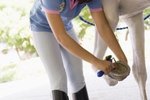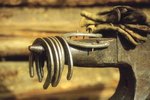A horse's hooves are part of their circulatory system, so good hoof care plays a vital role in horse ownership. They protect a horse's hooves from the hazards to which they have become more vulnerable to due to domestication and modern daily life. They provide traction on smooth or icy surfaces and help to prevent snowballs from forming in inclement conditions. Some horseshoes correct physical conditions, help to heal or even adjust the horse's gait. All of these shoes perform slightly differently.
Barefoot vs. Shod
Horses go barefoot -- without shoes -- all of the time. No one shoes the feral horses of the world. Horses who have been turned out to pasture are often left unshod, at least in the rear to prevent severe kicking injuries. Horses who work, sport and performance horses and riding horses of all kinds need to be shod based on the demands of their tasks.
Horseshoes hold the hoof in a static position; however, the hoof needs to expand and contract as part of its circulatory function. If a horse needs hoof repair or healing, the shoes are often removed as part of the therapy to restore some of the hooves natural function.
Protective Function
Wild and feral horses travel many miles each day in search of food and water. Much of these horses' environment consists of stone or sand, hard and abrasive surfaces that naturally trim and harden the hooves. Horses with thin hoof walls or soles are removed from the gene pools by natural selection, leading to improved hoof health.
The average horse shoe reduces friction from paved surfaces or sand by placing a barrier between the hoof and the ground. It also serves to distribute the weight on and impact of a hoof when being ridden. This equalizing process helps to prevent splits and breaks in the thinner hoof walls of domestic horses. Rubberized shoes create an ever greater barrier to impact injuries. Horseshoes equipped with snowball pads can prevent damage to the sensitive hoof sole and frog, as well as preventing slipping injuries.
Providing Traction
Horseshoes with rough soles can provide traction when it is needed. These shoes may be made of alternate materials, to further improve the horse's contact with the ground. Metal horseshoes can be fitted with studs to dig into the surface and prevent slipping. Working horses may have shoes fitted with studs that improve traction on the road, while racehorses may have studs fitted to improve their footing on dirt or grass tracks.
Special Functions
- Weighted shoes: Weighted shoes create resistance when a horse takes a step. This kind of shoe can be used to alter a gait, as in Tennessee Walking horses, or to strengthen a horse's legs.
- Corrective shoes: Shoes with added bars or special dimensions may be used to help heal medical conditions, such as founder, or repair cracks and splits.





